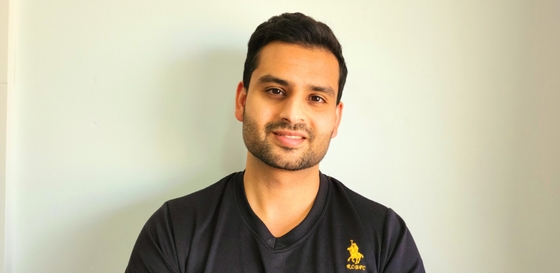
Q&A with Dr Md Ataur Rahman
Cyber-secured, battery-free, wireless ECG for on-spot and remote monitoring to prevent cardiovascular diseases
Dr Md Ataur Rahman is an electronic materials engineer, specialising in wearable electronics and their use for monitoring vital health signals, detecting air-borne hazardous substances, and mimicking sensory receptors for skin-like electronics. In 2023, Dr Rahman received a 2023 Postdoctoral Fellowship to develop a miniaturised wearable device for early-stage screening of vital signals for education and management of heart disease.
What are you currently researching?
We are working to improve the health and well-being of vulnerable people, including those in aged care facilities, neonatal care, and Aboriginal and Torres Strait Islander communities in remote areas. Our goal is to develop a cyber-secured, battery-free, and wireless electrocardiogram (ECG) system. This will allow real-time cardiovascular monitoring both on-site by users and remotely by healthcare professionals. This device aims to offer an effective early-stage detection process for heart disease and address the challenge of creating a standalone device for the medical technology (MedTech) industry.
What difference will your research make to people’s cardiovascular health in Australia?
Recent reports indicate the Australian population aged 60 or over is projected to nearly double over the next 30 years, from 5.9 million people in 2022 to between 9.9 million and 10.9 million in 2052. Aged-care costs is also expected to exceed $42 billion. With recent findings from the Royal Commission revealing shortcomings in the aged care sector, our project has the potential to significantly improve care quality and reduce costs. By digitally transforming aged care and enabling elderly people to stay at home longer, we can also address similar challenges in neonatal care and people living in remote areas, including Aboriginal and Torres Strait Islander communities.
Our project aims to create a cyber-secured, battery-free, wireless ECG for on-spot and remote monitoring to prevent cardiovascular diseases. This small and affordable device will transmit digitised and encrypted cardiovascular data, via the cloud, providing real-time ECG data to clinicians and enhancing telehealth services.
What motivated you to do your research?
Three key motivations drive my research:
- Starting each day with something new
- Finding easier solutions to problems people face, essentially making life easier
- Experiencing the excitement of translating research from the lab to the industry
As an electronic materials engineer deeply involved with the MedTech industry, the above motivations guide my work.
Are there any achievements or discoveries from the past year you can share with us?
In 2020, I reported on "Artificial somatosensors: Feedback receptors for electronic skin", demonstrating how electronic skin can react to pain like human skin. This work has reached over 1.5 billion people and gained significant media attention, including from MSN Germany, Daily Mail, Cosmos Magazine and ABC Radio National.
I have developed a technology that rapidly detects SARS-COV-2 proteins and its variants, as well as airborne viruses. This technology was first broadcasted on Nine News and covered in the US, China, Thailand, Vietnam, and Australia.
Moreover, my work on "Battery-free, wireless nicotine sensor" was listed as one of the most downloaded paper by Wiley publisher during the first year of publication. The work reported on the development of a wearable sensor to detect nicotine from tobacco products and electronic cigarettes in real-time, which can help to lower the risk of cardiovascular and respiratory disorders.
Recently, I published my work on Miniaturised 3-Lead ECG system based on Einthoven triangle for wireless cardiac care monitoring. This patented work is now undergoing the final stages of clinical trials in the National Health Services, UK.
What role has Heart Foundation funding had in your career journey?
Before I received my Heart Foundation Postdoctoral Fellowship, I was a research fellow in RMIT working with various industry-funded projects. These projects often have limited opportunities to explore new ideas as they usually have predefined milestones. This fellowship allows me to focus on developing my proposed project and also grow as an independent researcher. It supports my goal to establish an academic career focused on cardiovascular research.
Do you have a message for Heart Foundation supporters?
The gap in cardiovascular disease care between regional and urban areas is a significant health burden in Australia, especially in regions with sparse populations and limited health services. For example, in Western Australia, limited access to specialist cardiac care in rural and remote areas means that many patients are transferred to metropolitan hospitals for the treatment and management of their cardiovascular conditions. It is reported that cardiovascular hospitalisation rates were around 40% higher among those living in remote areas and 1.8 times higher for First Nations Peoples than non-First Nations Peoples. Our project aims to solve this problem by developing a secure, battery-free, wireless monitor for remote cardiovascular health monitoring, enabling real-time intervention and management by healthcare professionals.
Everyone should have access to real-time diagnostic and healthcare services, regardless of their location. I sincerely thank the Heart Foundation donors and supporters for providing me this opportunity to develop this cutting-edge technology.
You might also be interested in...

Key statistics: Cardiovascular disease
Statistics and information on cardiovascular disease in Australia.

New study finds targeted cardiovascular screening program effective in Australia
A Heart Foundation pilot program that recalls at-risk Australians via a text message from their GP clinic, is being seen as a potential lifesaver.

Q&A with Dr Umar Ali
Using simple blood and urine tests to detect coronary heart disease earlier.
Last updated09 April 2025
